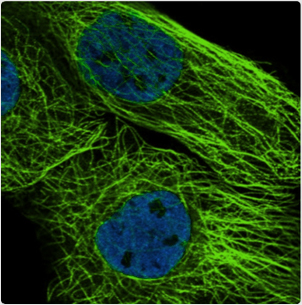EasyProbes™ ActinGreen 488 Stain is a selective, high-affinity F-actin probe conjugated to our bright, photostable, green-fluorescent Andy Fluor™ 488 dye. Our EasyProbes™ ActinGreen 488 Stain is formulated in a ready-to-use solution that is provided in a convenient-to-use dropper bottle. Just tip and drip two drops of stain solution to the cell slide to stain your cells.
Features
- High-affinity staining of F-actin with superior specificity compared to antibody methods
- Ready-to-use liquid formulation in convenient dropper bottle—no need to dilute, weigh, or pipette
- Bright fluorescence signal
Suggestions for use
- In most cases 2 drops of stain solution and an incubation of 15 to 30 minutes is sufficient for bright actin staining; however, optimization may be needed for some cell types, conditions, and applications. In such cases simply add more, or fewer drops until the optimal staining intensity is obtained.
- EasyProbes™ ActinGreen 488 Stain is excited with a maximum at 500 nm, with an emission maximum at 525 nm. It is detected through standard GFP and FITC filters.
| Specifications: |

|
|
| Excitation/Emission: | 500/525 nm | |
| Shipping Condition: | Ambient | |
| Storage Conditions: | 4ºC, protect from light | |
| Unit Size: | 5 mL |
| Protocol (PDF): | FP031 |
| MSDS (PDF): | FP031 |
| COA (PDF): | FP031 |
Reference:
Joshi B, Bastiani M, Strugnell SS, Boscher C, Parton RG, Nabi IR,
J Cell Biol (2012) 199:425-435
Drug-selected human lung cancer stem cells: cytokine network, tumorigenic and metastatic properties.
Levina V, Marrangoni AM, DeMarco R, Gorelik E, Lokshin AE,
PLoS One (2008) 3:e3077-e3077
Schimizzi GV, Currie JD, Rogers SL,
PLoS One (2010) 5:e11381-e11381

